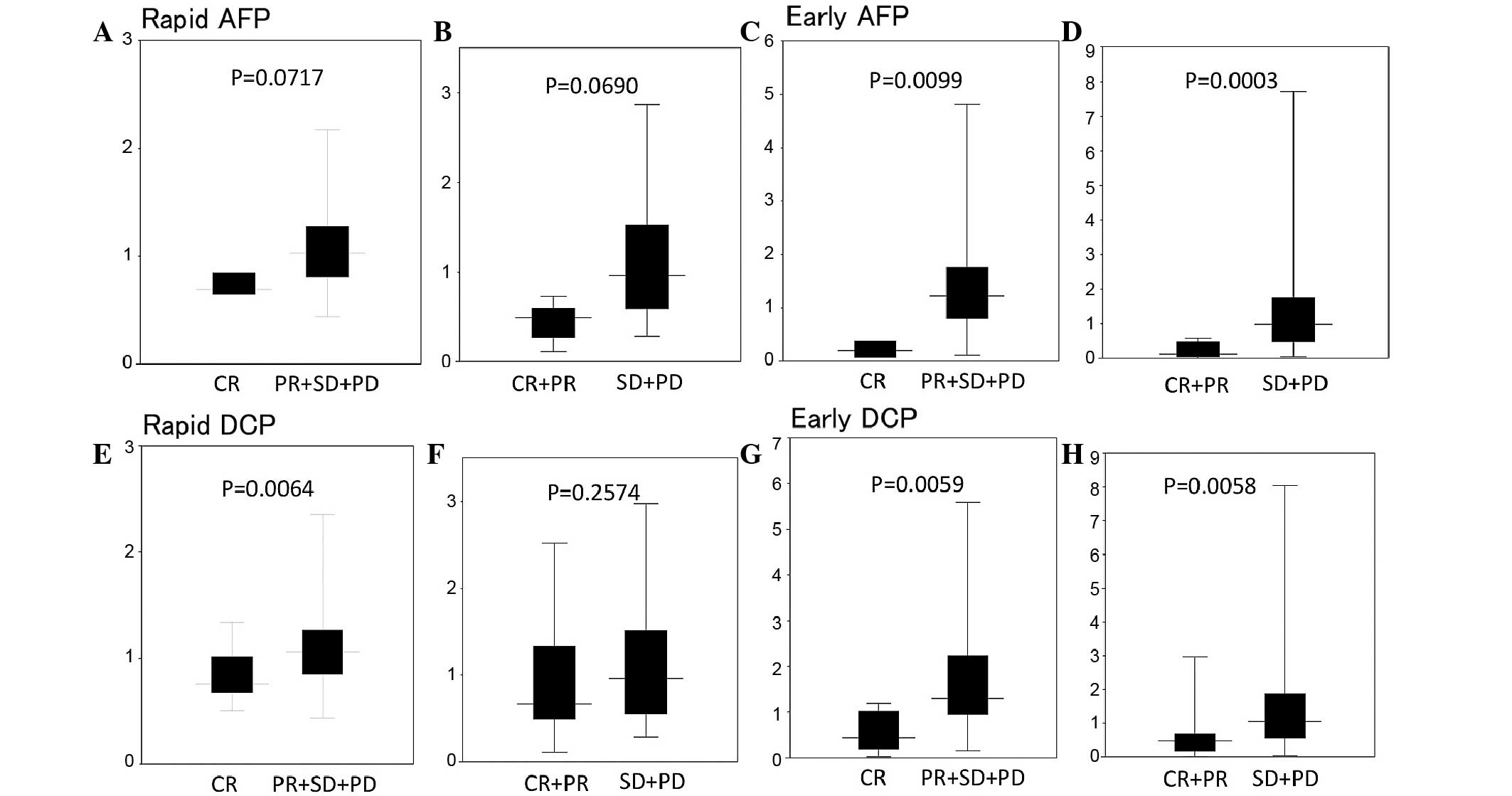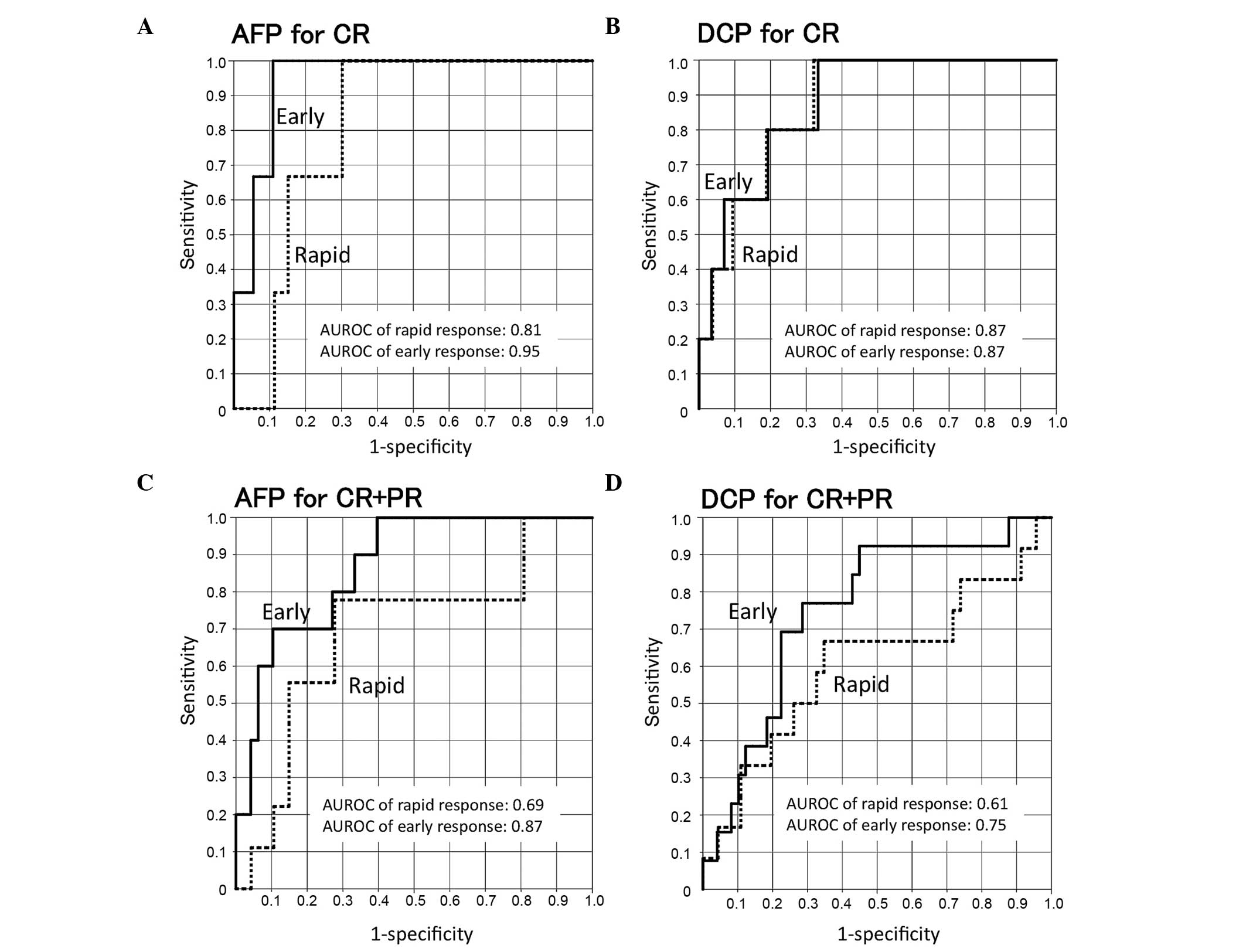|
1
|
El-Serag HB: Epidemiology of viral
hepatitis and hepatocellular carcinoma. Gastroenterology.
142:1264–1273. 2012. View Article : Google Scholar : PubMed/NCBI
|
|
2
|
Ferlay J, Shin HR, Bray F, Forman D,
Mathers C and Parkin DM: Estimates of worldwide burden of cancer in
2008: GLOBOCAN 2008. Int J Cancer. 127:2893–2917. 2010. View Article : Google Scholar : PubMed/NCBI
|
|
3
|
Blum HE: Hepatocellular carcinoma: Therapy
and prevention. World J Gastroenterol. 11:7391–7400.
2005.PubMed/NCBI
|
|
4
|
Furuse J: Sorafenib for the treatment of
unresectable hepatocellular carcinoma. Biologics. 2:779–788.
2008.PubMed/NCBI
|
|
5
|
Cheng AL, Kang YK, Chen Z, Tsao CJ, Qin S,
Kim JS, Luo R, Feng J, Ye S, Yang TS, et al: Efficacy and safety of
sorafenib in patients in the Asia-Pacific region with advanced
hepatocellular carcinoma: A phase III randomised, double-blind,
placebo-controlled trial. Lancet Oncol. 10:25–34. 2009. View Article : Google Scholar : PubMed/NCBI
|
|
6
|
Llovet JM, Ricci S, Mazzaferro V, Hilgard
P, Gane E, Blanc JF, de Oliveira AC, Santoro A, Raoul JL, Forner A,
et al: SHARP Investigators Study Group: Sorafenib in advanced
hepatocellular carcinoma. N Engl J Med. 359:378–390. 2008.
View Article : Google Scholar : PubMed/NCBI
|
|
7
|
Wörns MA, Weinmann A, Pfingst K,
Schulte-Sasse C, Messow CM, Schulze-Bergkamen H, Teufel A,
Schuchmann M, Kanzler S, Düber C, et al: Safety and efficacy of
sorafenib in patients with advanced hepatocellular carcinoma in
consideration of concomitant stage of liver cirrhosis. J Clin
Gastroenterol. 43:489–495. 2009. View Article : Google Scholar : PubMed/NCBI
|
|
8
|
Keating GM and Santoro A: Sorafenib: A
review of its use in advanced hepatocellular carcinoma. Drugs.
69:223–240. 2009. View Article : Google Scholar : PubMed/NCBI
|
|
9
|
Ma YT and Palmer DH: Impact of restricting
access to high-cost medications for hepatocellular carcinoma.
Expert Rev Pharmacoecon Outcomes Res. 12:465–473. 2012. View Article : Google Scholar : PubMed/NCBI
|
|
10
|
Miyaki D, Aikata H, Honda Y, Naeshiro N,
Nakahara T, Tanaka M, Nagaoki Y, Kawaoka T, Takaki S, Waki K, et
al: Hepatic arterial infusion chemotherapy for advanced
hepatocellular carcinoma according to Child-Pugh classification. J
Gastroenterol Hepatol. 27:1850–1857. 2012. View Article : Google Scholar : PubMed/NCBI
|
|
11
|
Nouso K, Miyahara K, Uchida D, Kuwaki K,
Izumi N, Omata M, Ichida T, Kudo M, Ku Y, Kokudo N, et al: Liver
Cancer Study Group of Japan: Effect of hepatic arterial infusion
chemotherapy of 5-fluorouracil and cisplatin for advanced
hepatocellular carcinoma in the Nationwide Survey of Primary Liver
Cancer in Japan. Br J Cancer. 109:1904–1907. 2013. View Article : Google Scholar : PubMed/NCBI
|
|
12
|
Bellet DH, Wands JR, Isselbacher KJ and
Bohuon C: Serum alpha-fetoprotein levels in human disease:
Perspective from a highly specific monoclonal radioimmunoassay.
Proc Natl Acad Sci USA. 81:3869–3873. 1984. View Article : Google Scholar : PubMed/NCBI
|
|
13
|
Weitz IC and Liebman HA: Des-gamma-carboxy
(abnormal) prothrombin and hepatocellular carcinoma: A critical
review. Hepatology. 18:990–997. 1993. View Article : Google Scholar : PubMed/NCBI
|
|
14
|
Vora SR, Zheng H, Stadler ZK, Fuchs CS and
Zhu AX: Serum alpha-fetoprotein response as a surrogate for
clinical outcome in patients receiving systemic therapy for
advanced hepatocellular carcinoma. Oncologist. 14:717–725. 2009.
View Article : Google Scholar : PubMed/NCBI
|
|
15
|
Chan SL, Mo FK, Johnson PJ, Hui EP, Ma BB,
Ho WM, Lam KC, Chan AT, Mok TS and Yeo W: New utility of an old
marker: Serial alpha-fetoprotein measurement in predicting
radiologic response and survival of patients with hepatocellular
carcinoma undergoing systemic chemotherapy. J Clin Oncol.
27:446–452. 2009. View Article : Google Scholar : PubMed/NCBI
|
|
16
|
Riaz A, Ryu RK, Kulik LM, Mulcahy MF,
Lewandowski RJ, Minocha J, Ibrahim SM, Sato KT, Baker T, Miller FH,
et al: Alpha-fetoprotein response after locoregional therapy for
hepatocellular carcinoma: Oncologic marker of radiologic response,
progression, and survival. J Clin Oncol. 27:5734–5742. 2009.
View Article : Google Scholar : PubMed/NCBI
|
|
17
|
Yamasaki T, Kimura T, Kurokawa F, Aoyama
K, Ishikawa T, Tajima K, Yokoyama Y, Takami T, Omori K, Kawaguchi
K, et al: Prognostic factors in patients with advanced
hepatocellular carcinoma receiving hepatic arterial infusion
chemotherapy. J Gastroenterol. 40:70–78. 2005. View Article : Google Scholar : PubMed/NCBI
|
|
18
|
Yamamoto K, Imamura H, Matsuyama Y, Kume
Y, Ikeda H, Norman GL, Shums Z, Aoki T, Hasegawa K, Beck Y, et al:
AFP, AFP-L3, DCP and GP73 as markers for monitoring treatment
response and recurrence and as surrogate markers of
clinicopathological variables of HCC. J Gastroenterol.
45:1272–1282. 2010. View Article : Google Scholar : PubMed/NCBI
|
|
19
|
Kudo M, Kubo S, Takayasu K, Sakamoto M,
Tanaka M, Ikai I, Furuse J, Nakamura K and Makuuchi M: Liver Cancer
Study Group of Japan (Committee for Response Evaluation Criteria in
Cancer of the Liver, Liver Cancer Study Group of Japan): Response
Evaluation Criteria in Cancer of the Liver (RECICL) proposed by the
Liver Cancer Study Group of Japan (2009 Revised Version). Hepatol
Res. 40:686–692. 2010. View Article : Google Scholar : PubMed/NCBI
|
|
20
|
Tateishi R, Yoshida H, Matsuyama Y, Mine
N, Kondo Y and Omata M: Diagnostic accuracy of tumor markers for
hepatocellular carcinoma: A systematic review. Hepatol Int.
2:17–30. 2008. View Article : Google Scholar : PubMed/NCBI
|
|
21
|
Kim Y, Paik YH, Ahn SH, Youn YJ, Choi JW,
Kim JK, Lee KS, Chon CY and Han KH: PIVKA-II is a useful tumor
marker for recurrent hepatocellular carcinoma after surgical
resection. Oncology. 72:(Suppl 1). 52–57. 2007. View Article : Google Scholar : PubMed/NCBI
|
|
22
|
Yamamoto K, Imamura H, Matsuyama Y,
Hasegawa K, Beck Y, Sugawara Y, Makuuchi M and Kokudo N:
Significance of alpha-fetoprotein and des-gamma-carboxy prothrombin
in patients with hepatocellular carcinoma undergoing hepatectomy.
Ann Surg Oncol. 16:2795–2804. 2009. View Article : Google Scholar : PubMed/NCBI
|
|
23
|
Toyoda H, Kumada T, Kaneoka Y, Osaki Y,
Kimura T, Arimoto A, Oka H, Yamazaki O, Manabe T, Urano F, et al:
Prognostic value of pretreatment levels of tumor markers for
hepatocellular carcinoma on survival after curative treatment of
patients with HCC. J Hepatol. 49:223–232. 2008. View Article : Google Scholar : PubMed/NCBI
|
|
24
|
Chen LT, Liu TW, Chao Y, Shiah HS, Chang
JY, Juang SH, Chen SC, Chuang TR, Chin YH and Whang-Peng J:
Alpha-fetoprotein response predicts survival benefits of
thalidomide in advanced hepatocellular carcinoma. Aliment Pharmacol
Ther. 22:217–226. 2005. View Article : Google Scholar : PubMed/NCBI
|
|
25
|
Kishi K, Sonomura T, Mitsuzane K, Nishida
N, Kimura M, Satoh M, Yamada R, Kodama N, Kinoshita M, Tanaka H, et
al: Time courses of PIVKA-II and AFP levels after hepatic artery
embolization and hepatic artery infusion against hepatocellular
carcinoma: Relation between the time course and tumor necrosis.
Radiat Med. 10:189–195. 1992.PubMed/NCBI
|
|
26
|
Lee MH, Kim SU, Kim Y, Ahn SH, Choi EH,
Lee KH, Lee Y, Seong J, Han KH, Chon CY, et al: Early on-treatment
predictions of clinical outcomes using alpha-fetoprotein and
des-gamma-carboxy prothrombin responses in patients with advanced
hepatocellular carcinoma. J Gastroenterol Hepatol. 27:313–322.
2012. View Article : Google Scholar : PubMed/NCBI
|
|
27
|
Kim BK, Ahn SH, Seong JS, Park JY, Kim Y,
Kim JK, Lee Y, Lee KH and Han KH: Early α-fetoprotein response as a
predictor for clinical outcome after localized concurrent
chemoradiotherapy for advanced hepatocellular carcinoma. Liver Int.
31:369–376. 2011. View Article : Google Scholar : PubMed/NCBI
|
|
28
|
Shao YY, Lin ZZ, Hsu C, Shen YC, Hsu CH
and Cheng AL: Early alpha-fetoprotein response predicts treatment
efficacy of antiangiogenic systemic therapy in patients with
advanced hepatocellular carcinoma. Cancer. 116:4590–4596. 2010.
View Article : Google Scholar : PubMed/NCBI
|














